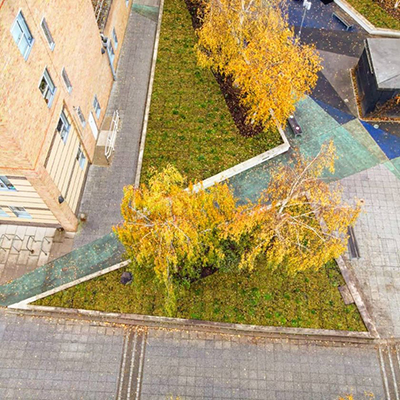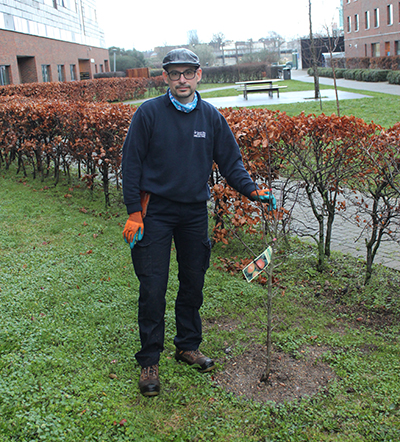Dimitrisz Sopisz, Grounds and Gardens Supervisor
Dimitrisz Sopisz is the Grounds and Gardens Supervisor at our Mile End campus. In his profile, he talks about the planting of our campus orchard and the sustainability inititiatives across the campus including building hedgehog houses and planting a wildflower lawn.
Tell us about yourself.
I am originally from Hungary. I studied Horticulture Sciences and have a BSc in Horticulture Engineering. I have over 17 years of experience in garden design, soft and hard landscaping, garden maintenance and consultancy. I recently started a course called Social Therapeutic Horticulture.
I moved to the UK in 2010. Since then, I have worked for a garden maintenance company, a private school in North London (Head Gardener), run my own business and looked after the grounds and gardens of two stately homes (Head Gardener).
How long have you worked at Queen Mary?
I’ve worked at Queen Mary for a year since January 2020 and I supervise five grounds staff. My team and I are responsible for the maintenance and improvement of all the grounds and gardens at the Mile End Campus. This includes anything from cleaning all external hard landscaping surfaces (litter picking, sweeping, emptying external bins, graffiti removal and pressure washing all external surfaces). My team looks after all the lawn areas, flower beds and borders, shrubberies and the cemetery. This includes anything from lawnmowing, hedge-trimming, planting, weeding and watering. In addition, I prepare short and long-term improvement plans.
Tell us about the projects you’ve completed since joining Queen Mary.
 Since I joined Queen Mary, the team and I completed several projects including:
Since I joined Queen Mary, the team and I completed several projects including:
- Replanting the Queen`s Building Courtyard
- Replanting all the planters in front of Peoples Palace, Queen`s building and Physics Avenue
- Planting over 1000 Gladiolus bulbs front of Queens building for summer bedding
- Starting a wildflower meadow project (by converting an existing ornamental lawn)
- Planting over 8000 Spring flowering bulbs (crocuses, narcissi, hyacinths, anemones, fritillaria and tulips)
- Planting over 1000 winter bedding plants at various locations on campus (cyclamen, polyanthus, violas and pansies)
- Starting to build several `bug hotels` across campus to encourage biodiversity
- Starting the planting of the campus orchard (which includes 60 trees and 170 soft fruit plants)
You’ve been instrumental in the planting of a community orchard at Mile End, tell us more about the project and what the plans are? How can staff and students get involved in the future?
 The Orchard is one of my dreams. I grew up in the countryside where we had a good number of different fruit trees. One day I was walking around the residential side of the campus and had a thought:What if we had an Orchard? I presented my idea to management and was given the go-ahead to get started.
The Orchard is one of my dreams. I grew up in the countryside where we had a good number of different fruit trees. One day I was walking around the residential side of the campus and had a thought:What if we had an Orchard? I presented my idea to management and was given the go-ahead to get started.
I chose apple and pear trees to start with as certain varieties do well in this environment. The trees are two years old which means they will fruit in two years’ time. The plan is to create an orchard for future generations – a legacy. I want to use the orchard to its full potential: organising workshops about fruit tree pruning, maintenance and harvesting.
Tell us more about the Queen Mary allotment, what are you growing and how are the crops being used?
The allotment is behind the Village Shop at Mile End and has eight raised beds. At the moment, we're growing tomatoes, lettuces, land cress, chard, chili peppers, bell peppers and horseradish. We've also planning to sow some more rocket, chicory, and purple and green tender-stem broccoli before the winter. The crops are for students and staff, and they will also be used in various dishes served in the Curve restaurant.
Queen Mary recently took part in planting some Black Poplar trees, can you tell us more about it and why it's so important to sustainability?
The Black Poplar planting was part of Queen Mary's recognition of World Environment Day. Mature trees grow to 30m and can live for 200 years. The bark is dark brown but often appears black. It is the food plant for the caterpillars of many moths, including the hornet, wood leopard, and poplar hawk The catkins provide an early source of pollen and nectar for bees and other insects, and the seeds are eaten by birds. Black poplar wood is fine textured, soft and fire resistance. Traditional uses included cartwheels and wagon bottoms and often used for floorboards, especially in the days of paraffin lamps. Our aim is to increase the natural tree population by planting these trees.
Describe your average day/week
Usually, my team and my days and week are planned. In the morning first thing I walk around the Campus to check everything. After that, I talk to my team about any unplanned work. Otherwise, everyone knows what needs to be done. In the afternoon I do my admin which could be anything from researching materials, pricing, or drawing landscaping plans.
What’s the best thing about your job?
I can create a wonderful environment and can work with some many nice people.
What’s planned for the future?
- Creating woodland settings by planting 120 ferns and 100 wild strawberries
- Increase the number of wild flower meadows
- Plant more fruit trees
- Setting up regular garden volunteering workshops with the Sustainability department
- Creating `pop up` vegetable plots across the campus
- Possibly extending the Orchard and creating a Japanese/Zen style garden
- Create more exciting and biodiverse green spaces
What do you see as your role in helping the University achieve its Strategy 2030?
I would say I can play a big part in the reduction of carbon footprint. Also, creating a welcoming and colourful campus: a place everybody wants to enjoy and visit.
What’s your favourite place on any of our campuses?
I love every part of the campus but if I must choose one it would be where we planted the orchard.
If you could tell a prospective student one thing about Queen Mary, what would it be?
It is a very welcoming and inclusive University.
If you hadn’t been Grounds and Garden Supervisor, what job would you have liked to do?
When I was young, I wanted to study medicine so I would probably have been a surgeon.
Do you have any unusual hobbies, pastimes outside of work?
I love reading, doing environmental and horticultural related courses, long distance running and cycling, and I started playing on violin a couple of years ago.